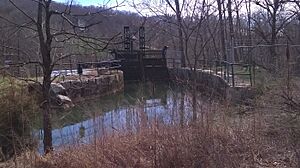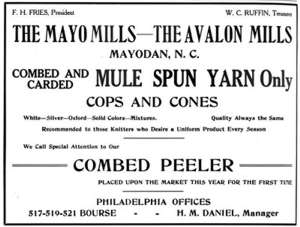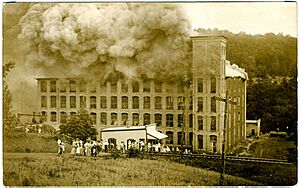Avalon, North Carolina facts for kids
Avalon was once a small town in Rockingham County, North Carolina, in the United States. It grew up around a big factory that made cloth, built by a man named Francis Henry Fries in the late 1800s. But in 1911, the factory burned down. After the fire, most people moved their houses to a nearby town called Mayodan, North Carolina. This left Avalon as an empty, forgotten place.
History of Avalon
How Avalon Began
In 1887, a smart businessman named Francis Henry Fries from Winston-Salem built a railroad. This railroad, called the Roanoke and Southern Railway, went all the way to Roanoke, Virginia. Mr. Fries wanted to build factories along this new train line. So, in 1895, he built a factory called the Mayo Mill next to the Mayo River. He also started the town of Mayodan there.
The Mayo Mill made a lot of yarn, but it couldn't make enough for everyone who wanted it. So, between 1899 and 1900, a new, bigger factory was built about two miles north. W. C. Ruffin, who managed the Mayo Mills Company, named this new factory "Avalon." He got the name from Avalon, California. This new factory was built by a company called S. S. Ordway & Sons. At the time, this four-story building was the largest textile mill (cloth factory) in North Carolina! One side of the building was made of wood. This was so it could be easily taken apart if they needed to make the factory even bigger later.
A small village grew up around the Avalon factory. It was also called Avalon. More than 450 people lived there, and over half of them worked in the factory. Some people moved to Avalon from places like Durham and Raleigh to find jobs. A few African-American families also lived on the edge of the village and worked in the factory's dye house.
Besides the factory, the town had a dam and a special water channel. There were also 60 houses for the factory workers, a boarding house, a hotel, and a company store. The store even had an ice cream parlor! A Moravian Church was also part of the town. The second floor of the company store was used as a school for the children. The factory had a water-powered generator that made electricity for the town. Avalon never had a formal town government. Most town events happened at the church or the factory. On November 23, 1908, a fire destroyed the company store. This fire caused about $20,000 in damage.
The Big Fire and What Happened Next
Just before 6 p.m. on June 15, 1911, a machine called a spinning mule box got too hot on the fourth floor of the factory. It caught fire! Wind blowing through the open windows made the flames grow quickly. The factory was just about to close for the day, so not many workers were inside when the fire started. One man tried to put out the fire with water, but it didn't work. The factory had a modern fire sprinkler system, but its water pumps failed. Because of this, the entire factory burned down in just a few hours.
The factory was fully insured, which means Mr. Fries got money from an insurance company. But he decided not to rebuild the Avalon factory. Instead, he used the insurance money to make the Mayo Mill bigger. He also moved his workers and machines from Avalon to Mayo Mill. Almost all of the company houses in Avalon were put on logs and rolled by mules and horses to Mayodan.
By 1913, only the Moravian Church, the old factory store, and one house were left in Avalon. The church and store were taken apart, and their wood was moved to Mayodan. The last house was left for the person who looked after the factory's power plant. In 1916, Mr. Fries came back to Avalon one last time. He took apart the dyeing equipment and moved it to the Mayo Mill.
Today, the remains of Avalon are about a mile from U.S. Route 220. They are on private land.




